For the 1984 Olympics in Los Angeles with the yachting events in Long Beach the IYRU kept the six classes from Tallinn: Finn, FD, Star, Soling, 470, Tornado and added a board, the Windglider. The Games suffered once again from a boycott, this time initiated by the USSR as a revenge for 1980. So in Long Beach the favourites from the DDR, Poland and the USSR were excluded. In the Finn class the actual Olympic sailing was preceded by an undignified controversy after the US trials. John Bertrand was declared the representative only 24 hours before the first start. In that race he had a collision with the later Gold medal winner Russell Courts from New Zealand and was disqualified. Disregarding the mental strain of the qualification battle and the disqualification in the first race, Bertrand was leading after the fifth and sixth race. In the last race however, he lost the Gold to Coutts, and Terry Neilson from Canada won the Bronze medal. |
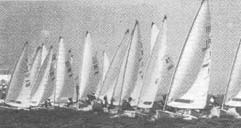 |
| The Olympic fleet in 1984 |
|
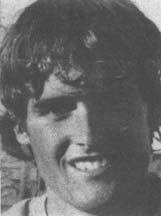 |
The 1988 Olympics were staged at Seoul, Korea with the regatta being held in the Bay of Pusan. The classes were the same as at Long Beach except now there were men's and women's divisions in the 470 class and the windsurfer. The final winner, Jose Luis Doreste, who had competed in both the 1976 and 1980 Olympics was disqualified in race 4 for a collision. The silver medalist Peter Holmberg was PMS in race 4 and one of the favourites Lasse Hjortnas broke his mast in race two after winning the first race. These events opened up the racing as one further bad result would drop these sailors down the Scoreboard. Eventually John Cutler won the last two races to take the bronze. Five men had a chance of winning going into the final race, but the final three medal winners finished in the reverse of that order with another favourite, Stuart Childerley (who had his best masts broken in transit), finishing sixth in the race and fourth overall.
|
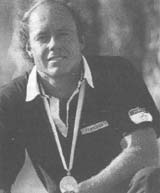 |
Gold Medal Winner 1984
Russell Coutts |
Gold Medal Winner 1988
Jose Doreste |
|
| Another Finn sailor to get a medal was Larry Lemieux who gave up a good position in the fifth race to rescue a Singapore 470 sailor from the water after he had lost contact with his boat. He was awarded a silver medal for this feat. Once again the sailors had to use boats that were provided by the organisers, and although they were similar to each other they were not as quick as the sailors own boats. |
The 1992 Olympic Regatta was held in Barcelona, Spain in generally light to moderate conditions. The only change to the classes was the introduction of the Europe class as the women's singlehander. The Finn fleet was the deepest ever and it was generally agreed that anyone in the first 15 could win the Gold Medal and anyone of the first 22 could win a race. The boats were provided by Vanguard of the USA and although the boats were excellent and more importantly equal, everyone of course could detect differences from their personal boats. The final winner Jose Maria van der Ploeg never scored worse than sixth and didn't have to sail the final race. The two favourites, current World Champion Eric Mergenthaler and three times Laser World Champion Glenn Bourke performed poorly and finished 18th and 20th. |
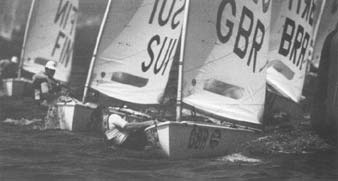 |
| The Olympic fleet in 1992 |
Double world Champion Hank Lammens blew his chances with a DSQ in race two for not having the required life jacket on board and a PMS in race three. Brian Ledbetter was one of the few consistent sailors and won the Silver medal. In the manner of John Cutler four years earlier, Craig Monk, also from New Zealand, won the last race the snatch the bronze away from Stuart Childerley again. Prior to the regatta, the IFA conducted a two week training clinic for those countries desiring assistance. |
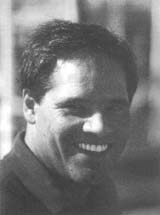 |
Whilst some people inside and outside of the Finn class saw the Laser as a possible threat to its Olympic status, many also saw the benefits of this popular class in acting as a feeder to the Finn class. In fact the majority of Finn Champions in recent years had sailed the Laser at some point, most of them successfully and had regarded the Firm as the next logical step in singlehanded sailing, the Finn being regarded as the supreme singlehanded challenge. Therefore when the numerically stronger Laser was bidding for Olympic status many thought that it would replace the Finn as the Olympic singlehander for men. However this was not to be as the Flying Dutchman was dropped instead and the Olympics in 1996 were to have two singlehanded dinghies. This worked well, as it meant that there was effectively two boats for two different weight categories: Lasers for the lightweight helms and the Finn for the heavier helm. At present it was considered impossible to have a singlehander that would suit all weights of sailor, and two singlehanders provided the best solution for this problem as well as allowing more countries to be represented at the Games at less cost. Without the Finn, the heavyweight helm had no chance of sailing a dinghy at the Olympic Games.
|
Gold Medal Winner 1992
Jose Maria van der Ploeg |
|
In the 1996 Atlanta Olympics, the Laser replaced the Flying Dutchman and all other classes remained the same: Finn, 470 (M&W), Europe (W), Windsurfer (M&W), Soling, Star, Tornado. The advance weather reports for Savannah, USA, suggested a light wind regatta. However, this was not to be and thunderstorm activity resulted in some spectacular weather and strong winds. Poland's first ever sailing medal was won by Mateusz Kusznierewicz with a race to spare, and this in spite of losing his watch early on in the series and using the clock on the starting boat instead. After an inconsistent start, a 1, 2, 1, 1 in the latter half of the series sealed the Gold Medal. Sebastien Godefroid from Belgium took the Silver with only one result to count outside the top 7, whilst relative Olympic veteran Roy Heiner took the Bronze on the last race with a second place, to relegate Hans Spitzauer to fourth.
|
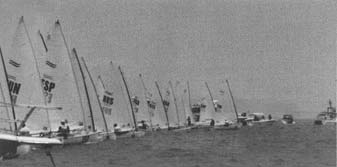 |
| The Fleet at the Olympics in 1996 |
|
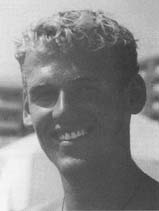 |
The current world champion Philippe Presti only had a few good results and never found the form that won him his second Gold Cup a few months before. Defending champion and current European champion Jose Maria van der Ploeg started well by winning the first race and then remained inconsistent to the end of the series.
At the end of 1996, the classes for 2000, in Sydney, Australia were chosen by ISAF. Again it was decided to have three singlehanded dinghies in the Olympics: Finn, Laser and Europe. The singlehanded dinghy provides the best possible realisation of the Olympic ideal, athletes at the top of their sport battling out a competition one-on-one, so it is only natural that every sailor has the chance to sail a singlehanded dinghy at the Olympic Games. Many classes went into overdrive to ensure the Olympic survival of their class and in a bizarre twist, the Star was dropped for the second time in its Olympic history to be replaced by the skiff-type boat, the 49'er. However by 1998, the Star was reinstated in its Olympic slot when the IOC gave the sailing events for 2000 another set of medals.
|
Gold Medal Winner 1996
Mateusz Kusznierewicz |
|
| 1984 Long Beach, USA (28 entries) |
| 1. |
Russell Coutts |
KZ |
34.7 |
| 2. |
John Bertrand |
US |
37.0 |
| 3. |
Terry Neilson |
ÊÑ |
37.7 |
| 4. |
Joaquin Blanco |
E |
60.7 |
| 5. |
Wolfgang Gerz |
G |
66.1 |
| 6. |
Chris Pratt |
KA |
68.0 |
| 7. |
Michael McIntyre |
Ê |
70.7 |
| 8. |
Jorge Zarif Neto |
BL |
78.7 |
| 9. |
Mark Neeleman |
H |
81.7 |
| 10. |
Ingvar Bengtsson |
S |
84.0 |
| 11. |
Peter Holmberg |
VI |
86.0 |
| 12. |
Lasse Hjortnas |
D |
93.7 |
| 13. |
William O'Hara |
IR |
96.0 |
| 14. |
Esko Rechardt |
L |
105.7 |
| 1988 Pusan, Korea (33 entries) |
| 1. |
Jose Luis Doreste |
E |
38.1 |
| 2. |
Peter Holmberg |
VI |
40.4 |
| 3. |
John Cutler |
KZ |
45.0 |
| 4. |
Stuart Childerley |
Ê |
50.7 |
| 5. |
Lasse Hjortnas |
D |
51.0 |
| 6. |
Thomas Schmid |
G |
72.1 |
| 7. |
Roy Heiner |
H |
78.4 |
| 8. |
Oleg Khoperski |
SR |
81.0 |
| 9. |
Lauri Rechardt |
L |
88.8 |
| 10. |
Brian Ledbetter |
US |
91.0 |
|
| 1992 Barcelona, Spain (28 entries) |
| 1. |
Jose Maria van der Ploeg |
ESP |
33.4 |
| 2. |
Brian Ledbetter |
USA |
54.7 |
| 3. |
Craig Monk |
NZL |
64.7 |
| 4. |
Stuart Childerley |
GBR |
68.1 |
| 5. |
Fredrik Loof |
SWE |
68.7 |
| 6. |
Othmar Muller v Blumencron |
SUI |
70.0 |
| 7. |
Xavier Rohart |
FRA |
75.0 |
| 8. |
Hans Spitzauer |
AUT |
79.4 |
| 9. |
Armando Ortolano |
GRE |
81.7 |
| 10. |
Christoph Bergmann |
BRA |
84.0 |
| 11. |
Arif Gurdenli |
TUR |
94.7 |
| 12. |
Stig Westergaard |
DEN |
97.7 |
| 13. |
Hank Lammens |
CAN |
102.0 |
| 14. |
Emanuele Vaccari |
ITA |
103.0 |
| 15. |
Peter Aldag |
GER |
108.0 |
| 16. |
Oleg Khoperski |
EUN |
108.0 |
|
| 1996 Savannah, USA (31 entries) |
| 1. |
Mateusz Kusznierewicz |
POL |
32 |
| 2. |
Sebastien Godefroid |
BEL |
45 |
| 3. |
Roy Heiner |
NED |
50 |
| 4. |
Hans Spitzauer |
AUT |
54 |
| 5. |
Fredrik Loof |
SWE |
57 |
| 6. |
Paul McKenzie |
AUS |
67 |
| 7. |
Jose Maria van der Ploeg |
ESP |
69 |
| 8. |
Ian Ainslie |
RSA |
72 |
| 9. |
Richard Clarke |
CAN |
75 |
| 10. |
Christoph Bergmann |
BRA |
79 |
| 11. |
Jali Makila |
FIN |
82 |
| 12. |
Richard Stenhouse |
GBR |
83 |
| 13. |
Craig Monk |
NZL |
86 |
| 14. |
Michael Maier |
CZE |
86 |
| 15. |
Philippe Presti |
FRA |
87 |
| 16. |
Luca Devoti |
ITA |
90 |
| 17. |
Yuri Tokovoi |
UKR |
91 |
| 18. |
Oleg Khoperski |
RUS |
107 |
| 19. |
Karlo Kuret |
CRO |
109 |
|
|
Conclusion
The Olympics were established as an international festival of athletes who have accepted the challenge of measuring themselves against one another to determine the best. Dedication, perseverance, imagination and creativity, stamina, self-discipline, self- reliance, working with others, and sacrifice are the attributes required to be a winning Olympic participant. Unfortunately, in the beginning, the Olympic yachting events were strictly for the wealthy with large boats and paid crews, who raced with their pocketbooks by trying to have the fastest designed boat. We have progressed a long way since those days. There is continuing pressure placed on the ISAF to add classes to the Olympic events and they have increased from three in 1924 to the present 11 events (9 classes). Due to the mounting costs further increases are impractical and would only serve to dilute interest in the other events. So then there is pressure on the ISAF to change the classes. The ISAF must remember the purpose of the Olympics when deciding the events for future Olympics.
The Monotype event was added to the Olympics in 1920 so that one yachting event would be available to all nations as the host country would provide the boat and that only pure sail-boat racing skill would be exhibited and design and special equipment would not be a factor.
A problem in these events up to 1948 was, that the type of boat was changed for each Olympic Game. Participants had difficulty learning the characteristics of the new class and to practice and develop their skills. With the introduction of the Finn in 1952 this problem was solved. The Finn was designed as an Olympic singlehander that could be sailed worldwide and aspiring Olympic candidates could practice and develop the required skills prior to the games. In the world today, there are a group of highly dedicated and determined athletes constantly practising in the Finn.
The changes in the Olympic classes throughout the years have been to eliminate the money and design influence on the games and to make the yachting events reflect the spirit and purpose of the Olympics. The Finn class, having been born with this in mind, has established strict class rales and regulations to reflect this. Because of this the Finn has proven to be a true Olympic class reflecting the Olympic spirit. Attempts to find another class that adequately tests the true meaning of Olympic competition have failed.
The ISAF must keep class changes to a minimum as such changes are unfair to the true Olympic competitor as it requires him to redevelop his skills and dedication. It also puts financial burdens on the class itself to promote and maintain its Olympic status and also on the many countries and sailors around the world who have invested time, training and gear in these classes. Unless another type of boat is proven to be superior in demonstrating the skills, stamina, dedication and perseverance of a true Olympic athlete, the classes should not be changed. The intense devotion to the Finn competition by many fine sailors throughout the world and a large number of former Finn sailors in other classes in the Olympics who learned their Olympic competitive spirit in the Finn class, demonstrates that the Finn class is a true Olympic Class and will be retained until a better class can prove superiority to the true Olympics spirit. Therefore it would be quite logical, that the ISAF selects the Finn again as the singlehander for future Olympics. |
|